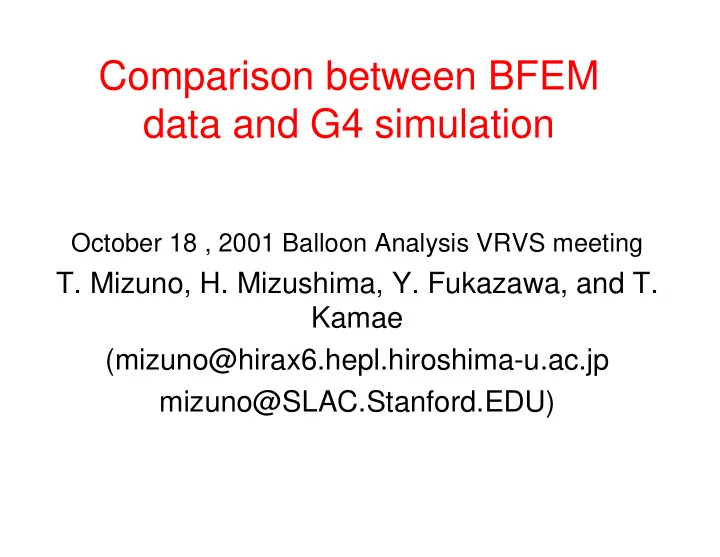

Comparison between BFEM data and G4 simulation October 18 , 2001 Balloon Analysis VRVS meeting T. Mizuno, H. Mizushima, Y. Fukazawa, and T. Kamae (mizuno@hirax6.hepl.hiroshima-u.ac.jp mizuno@SLAC.Stanford.EDU)
Overview of this study •Main purpose of this work is to construct reliable Cosmic-Ray generator and BFEM simulator. •In order to do this, we have been constructing cosmic-ray generators and running Geant4 simulator. •We regard that major components of cosmic-ray particles are CR proton, electron, positron, gamma, and muon, and constructed their generators. •For proton and electron generator, see LAT-TD-250.1 (and note that electron spectrum are now extrapolated down to 10MeV with E^-1). We are also preparing a description for others. •We have not reach goal. We need to improve the simulator and generators by comparing BFEM data and simulation results (L1T rate, neutron event rate, hit distribution in TKR).
Distribution of Top-most hit layer BFEM data vs. G4 simulation Contribution of each component muon(plus) muon(minus) gamma positron electron � � Proton Calorimeter Top of TKR observed L1T rate = ~500Hz simulated L1T rate = ~560Hz •proton:~205Hz •electron:~95Hz •positron:~60Hz •gamma:~105Hz •muon:~90Hz
Distribution of Hit Frequency Contribution of each component BFEM data vs. G4 simulation muon(plus) muon(minus) gamma positron electron proton Slight deviation is seen in layer 0-5 and 10-15.
Distribution of Hit Frequency for neutral events Contribution of each component BFEM data vs. G4 simulation muon(plus) muon(plus) gamma positron electron proton observed = ~50Hz simulated = 67Hz •proton:~4Hz gamma-ray is dominant in layer 15 or •electron:~12Hz higher, and in this region, simulation •positron:~7Hz overestimates hit frequency. We may •gamma:~40Hz need to adjust gamma-ray flux or •muon:~4Hz angular distribution.
Summary •We plan to construct reliable CR generators and simulator. •We have constructed CR proton, electron, positron, gamma, and muon generators. •Observed data and simulation show good agreement in L1T rate (500Hz vs. 560Hz) •There exists a slight difference in hit distribution in TKR. Neutral event rate of simulation is larger than that of real data. Future plan •Adjust CR generator, especially gamma-ray flux and angular dependence. •Combine two CR particles and see the effect. •Update simulator (support structure for BFEM). •Apply proton/muon cuts to both real data and simulation data, and adjust proton (muon) flux in generator.
Recommend
More recommend